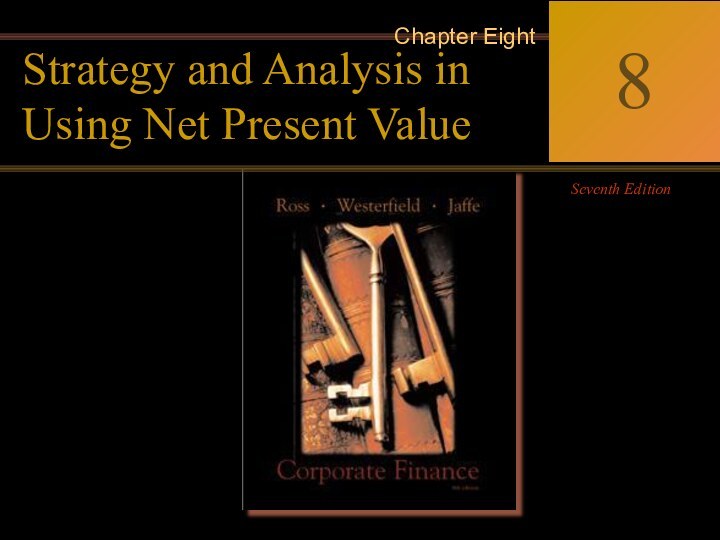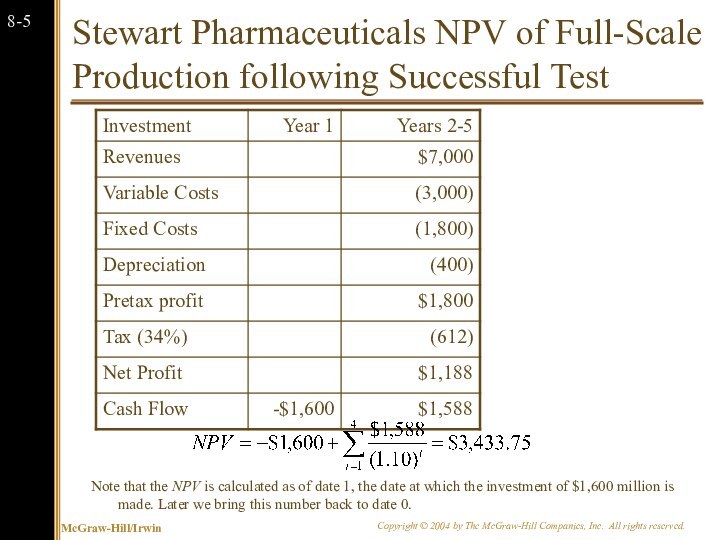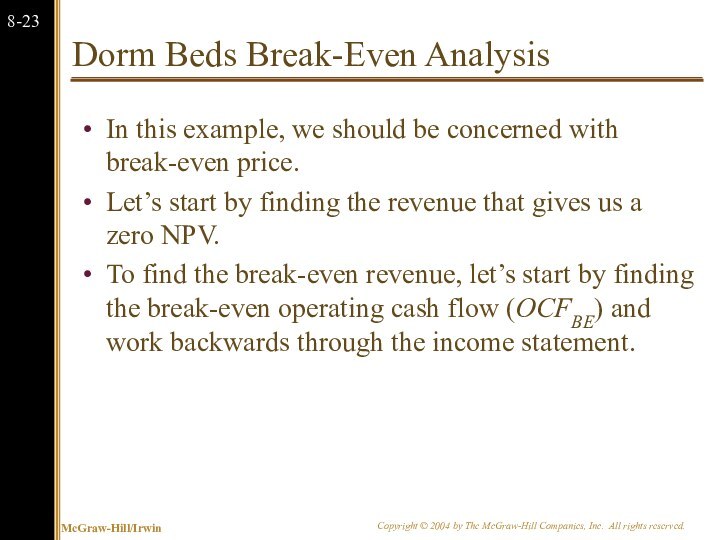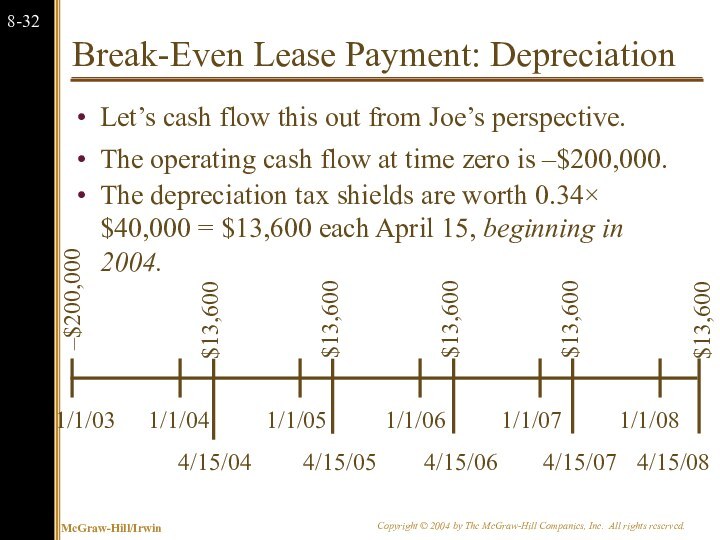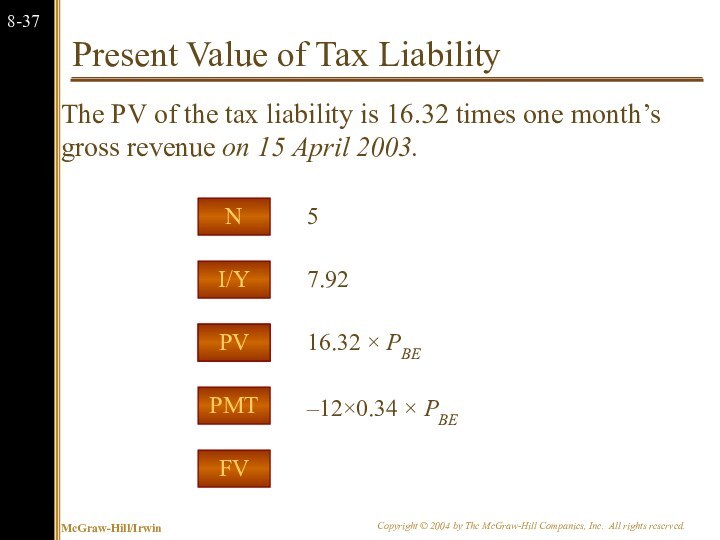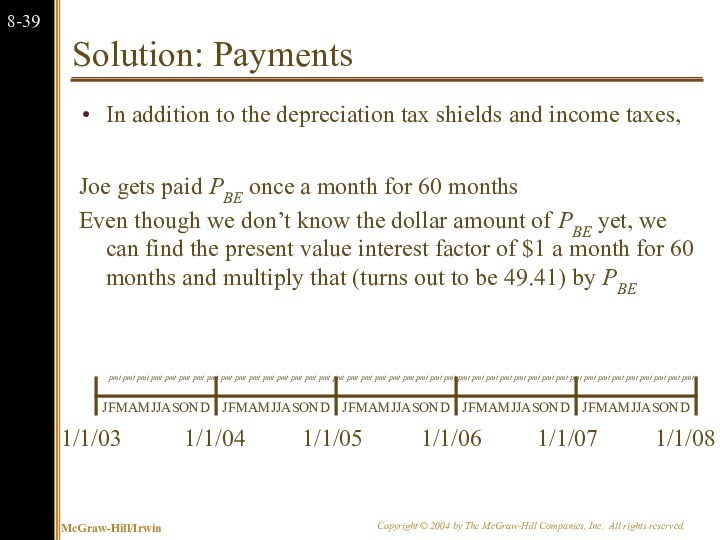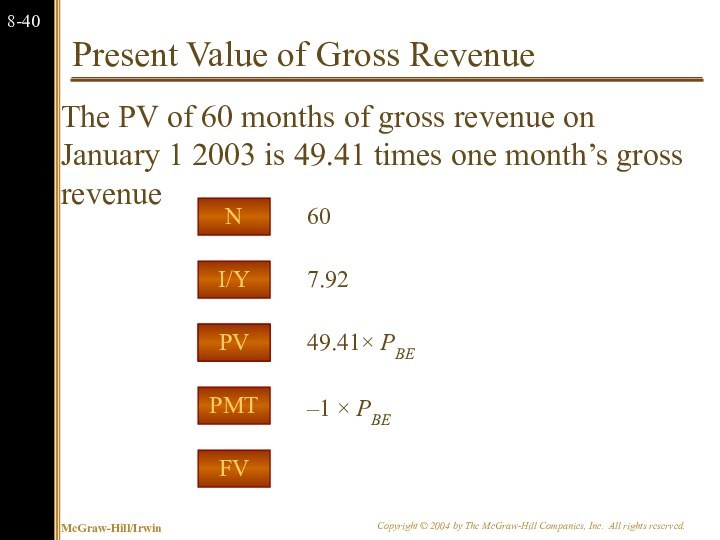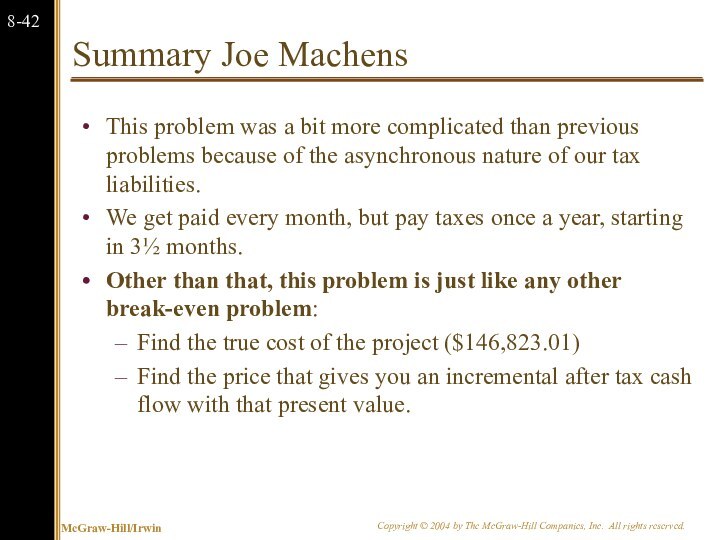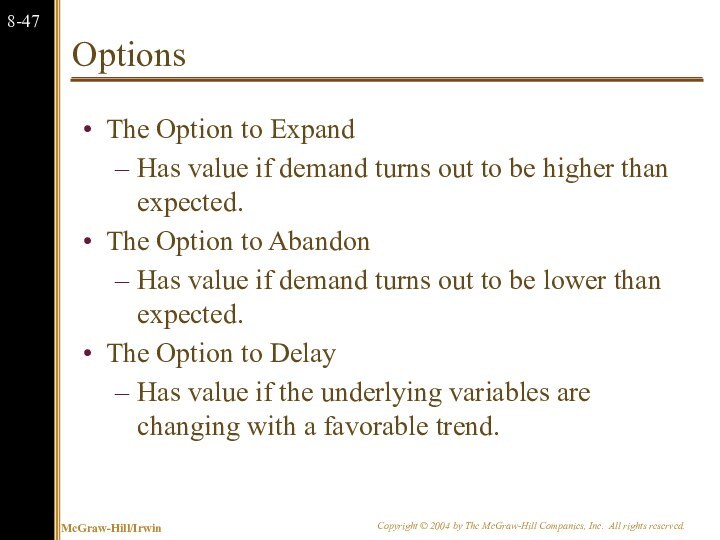Слайд 2
Chapter Outline
8.1 Decision Trees
8.2 Sensitivity Analysis, Scenario Analysis,
and
Break-Even
Analysis
8.3 Monte Carlo Simulation
8.4 Options
8.5 Summary and Conclusions
Слайд 3
8.1 Decision Trees
Allow us to graphically represent the
alternatives available to us in each period and the
likely consequences of our actions.
This graphical representation helps to identify the best course of action.
Слайд 4
Example of Decision Tree
Do not study
Study finance
Squares represent
decisions to be made.
Circles represent receipt of information e.g.
a test score.
The lines leading away from the squares represent the alternatives.
Слайд 5
Stewart Pharmaceuticals
The Stewart Pharmaceuticals Corporation is considering
investing in developing a drug that cures the common
cold.
A corporate planning group, including representatives from production, marketing, and engineering, has recommended that the firm go ahead with the test and development phase.
This preliminary phase will last one year and cost $1 billion. Furthermore, the group believes that there is a 60% chance that tests will prove successful.
If the initial tests are successful, Stewart Pharmaceuticals can go ahead with full-scale production. This investment phase will cost $1.6 billion. Production will occur over the next 4 years.
Слайд 6
Stewart Pharmaceuticals NPV of Full-Scale Production following Successful
Test
Note that the NPV is calculated as of date
1, the date at which the investment of $1,600 million is made. Later we bring this number back to date 0.
Слайд 7
Stewart Pharmaceuticals NPV of Full-Scale Production following Unsuccessful
Test
Note that the NPV is calculated as of date
1, the date at which the investment of $1,600 million is made. Later we bring this number back to date 0.
Слайд 8
Decision Tree for Stewart Pharmaceutical
Do not test
Test
Failure
Success
Do not
invest
Invest
The firm has two decisions to make:
To test or
not to test.
To invest or not to invest.
NPV = $3.4 b
NPV = $0
NPV = –$91.46 m
Слайд 9
Stewart Pharmaceutical: Decision to Test
Let’s move back to
the first stage, where the decision boils down to
the simple question: should we invest?
The expected payoff evaluated at date 1 is:
The NPV evaluated at date 0 is:
So we should test.
Слайд 10
8.3 Sensitivity Analysis, Scenario Analysis, and Break-Even Analysis
Allows
us to look the behind the NPV number to
see firm our estimates are.
When working with spreadsheets, try to build your model so that you can just adjust variables in one cell and have the NPV calculations key to that.
Слайд 11
Sensitivity Analysis: Stewart Pharmaceuticals
We can see that
NPV is very sensitive to changes in revenues. In
the Stewart Pharmaceuticals example, a 14% drop in revenue leads to a 61% drop in NPV
For every 1% drop in revenue we can expect roughly a 4.25% drop in NPV
Слайд 12
Scenario Analysis: Stewart Pharmaceuticals
A variation on sensitivity
analysis is scenario analysis.
For example, the following three scenarios
could apply to Stewart Pharmaceuticals:
The next years each have heavy cold seasons, and sales exceed expectations, but labor costs skyrocket.
The next years are normal and sales meet expectations.
The next years each have lighter than normal cold seasons, so sales fail to meet expectations.
Other scenarios could apply to FDA approval for their drug.
For each scenario, calculate the NPV.
Слайд 13
Break-Even Analysis: Stewart Pharmaceuticals
Another way to examine
variability in our forecasts is break-even analysis.
In the Stewart
Pharmaceuticals example, we could be concerned with break-even revenue, break-even sales volume or break-even price.
To find either, we start with the break-even operating cash flow.
Слайд 14
Break-Even Analysis: Stewart Pharmaceuticals
The project requires an investment
of $1,600.
In order to cover our cost of
capital (break even) the project needs to throw off a cash flow of $504.75 each year for four years.
This is the projects break-even operating cash flow, OCFBE
PMT
I/Y
FV
PV
N
− 504.75
10
0
1,600
4
PV
Слайд 15
Break-Even Revenue Stewart Pharmaceuticals
Work backwards from OCFBE
to Break-Even Revenue
Revenue
$5,358.72
Variable cost
$3,000
Fixed cost
$1,800
Depreciation
$400
EBIT
$158.72
Tax (34%)
$53.97
Net Income
$104.75
OCF =
$104.75 + $400
$504.75
Слайд 16
Break-Even Analysis: PBE
Now that we have break-even revenue
as $5,358.72 million we can calculate break-even price.
The original
plan was to generate revenues of $7 billion by selling the cold cure at $10 per dose and selling 700 million doses per year,
We can reach break-even revenue with a price of only:
$5,358.72 million = 700 million × PBE
Слайд 17
Break-Even Analysis: Dorm Beds
Recall the “Dorm beds” example
from the previous chapter.
We could be concerned with break-even
revenue, break-even sales volume or break-even price.
Слайд 18
Dorm Beds Example
Consider a project to supply the
University of Missouri with 10,000 dormitory beds annually for
each of the next 3 years.
Your firm has half of the woodworking equipment to get the project started; it was bought years ago for $200,000: is fully depreciated and has a market value of $60,000. The remaining $100,000 worth of equipment will have to be purchased.
The engineering department estimates you will need an initial net working capital investment of $10,000.
Слайд 19
Dorm Beds Example
The project will last for 3
years. Annual fixed costs will be $25,000 and variable
costs should be $90 per bed.
The initial fixed investment will be depreciated straight line to zero over 3 years. It also estimates a (pre-tax) salvage value of $10,000 (for all of the equipment).
The marketing department estimates that the selling price will be $200 per bed.
You require an 8% return and face a marginal tax rate of 34%.
Слайд 20
Dorm Beds OCF0
What is the OCF in year
zero for this project?
Cost of New Equipment $100,000
Net Working Capital
Investment $10,000
Opportunity Cost of Old Equipment $39,600 = $60,000 × (1-.34)
$149,600
Слайд 21
Dorm Beds OCF1,2
What is the OCF in years
1 and 2 for this project?
Revenue
10,000× $200 =
$2,000,000
Variable
cost
10,000 × $90 =
$900,000
Fixed cost
$25,000
Depreciation
100,000 ÷ 3 =
$33,333
EBIT
$1,041,666.67
Tax (34%)
$354,166.67
Net Income
$687,500
OCF =
$687,500 + $33,333
$720,833.33
Слайд 22
Dorm Beds OCF3
We get our $10,000 NWC back
and sell the equipment.
The after-tax salvage value is $6,600
= $10,000 × (1 – .34)
Thus, OCF3 = $720,833.33 + $10,000 + $6,600 = $737,433.33
Revenue
10,000× $200 =
$2,000,000
Variable cost
10,000 × $90 =
$900,000
Fixed cost
$25,000
Depreciation
100,000 ÷ 3 =
$33,333
EBIT
$1,041,666.67
Tax (34%)
$354,166.67
Net Income
$687,500
OCF =
$687,500 + $33,333
$720,833.33
Слайд 23
Dorm Beds “Base-Case” NPV
First, set your calculator to
1 payment per year.
Then, use the cash flow menu:
CF2
CF1
F2
F1
CF0
2
$720,833.33
1
1,721,235.02
−149,600
$737,433.33
I
NPV
8
Слайд 24
Dorm Beds Break-Even Analysis
In this example, we should
be concerned with break-even price.
Let’s start by finding the
revenue that gives us a zero NPV.
To find the break-even revenue, let’s start by finding the break-even operating cash flow (OCFBE) and work backwards through the income statement.
Слайд 25
Dorm Beds Break-Even Analysis
The PV of the cost
of this project is the sum of $149,600 today
less the $16,600 salvage value and return of NWC in year 3.
CF2
CF1
F2
F1
CF0
2
$0
1
− 136,422.38
−149,600
$16,600
I
NPV
8
Слайд 26
Break-Even Analysis: OCFBE
First, set your calculator to 1
payment per year.
PMT
I/Y
FV
PV
N
52,936.46
8
0
− 136,422.38
3
PV
Then find the operating cash
flow the project must produce each year to break even:
Слайд 27
Break-Even Revenue
Work backwards from OCFBE to Break-Even Revenue
Revenue
10,000×
$PBE =
$988,035.04
Variable cost
10,000 × $90 =
$900,000
Fixed cost
$25,000
Depreciation
100,000
÷ 3 =
$33,333
EBIT
$29,701.71
Tax (34%)
$10,098.58
Net Income
$19,603.13
OCF =
$19,603.13 + $33,333
$52,936.46
Слайд 28
Break-Even Analysis
Now that we have break-even revenue we
can calculate break-even price
If we sell 10,000 beds, we
can reach break-even revenue with a price of only:
PBE × 10,000 = $988,035.34
PBE = $98.80
Слайд 29
Common Mistake in Break-Even
What’s wrong with this line
of reasoning?
With a price of $200 per bed, we
can reach break-even revenue with a sales volume of only:
As a check, you can plug 4,941 beds into the problem and see if the result is a zero NPV.
Слайд 30
Don’t Forget that Variable Cost Varies
Revenue
QBE × $200
=
$88,035.04 + QBE× $110
Variable cost
QBE × $90 =
$?
Fixed cost
$25,000
Depreciation
100,000 ÷ 3 =
$33,333
EBIT
$29,701.71
Tax (34%)
$10,098.58
Net Income
$19,603.13
OCF =
$19,603.13 + $33,333
$52,936.46
Слайд 31
Break-Even Analysis
With a contribution margin of $110 per
bed, we can reach break-even revenue with a sales
volume of only:
If we sell 10,000 beds, we can reach break-even gross profit with a contribution margin of only $8.80:
CMBE ×10,000 = $88,035.04
CMBE = $8.80
If variable cost = $90, then PBE = $98.80
Слайд 32
Break-Even Lease Payment
Joe Machens is contemplating leasing the
University of Missouri a fleet of 10 minivans. The
cost of the vehicles will be $20,000 each. Joe is in the 34% tax bracket; the University is tax-exempt. Machens will depreciate the vehicles over 5 years straight-line to zero. There will be no salvage value. The discount rate is 7.92% per year APR. They pay their taxes on April 15 of each year. Calculate the smallest MONTHLY lease payment that Machens can accept. Assume that today is January 1, 2003 and the first payment is due on January 31, 2003
Слайд 33
Break-Even Lease Payment: Depreciation
Let’s cash flow this out
from Joe’s perspective.
The operating cash flow at time zero
is –$200,000.
The depreciation tax shields are worth 0.34×$40,000 = $13,600 each April 15, beginning in 2004.
1/1/03
1/1/04
1/1/05
1/1/06
1/1/07
1/1/08
4/15/08
$13,600
4/15/04
$13,600
4/15/05
$13,600
4/15/06
$13,600
4/15/07
$13,600
–$200,000
Слайд 34
Present Value of Depreciation Tax Shield
The PV of
the depreciation tax shields on April 15, 2003 is
$54,415.54.
PMT
I/Y
FV
PV
N
13,600
7.92
0
–54,415.54
5
PV
Слайд 35
Present Value of Depreciation Tax Shield
The PV of
the depreciation tax shields on January 1 2003 is
$53,176.99
53,176.99
PMT
I/Y
FV
PV
N
7.92
0
–54,415.54
3.5
PV
Слайд 36
Where we’re at so far:
The cars do not
cost Joe Machens $200,000.
When we consider the present value
of the depreciation tax shields, they only cost Joe
$200,000 – $53,176.99 = $146,823.01
Had there been salvage value it would be even less.
Now we need to find out how big the price has to be each month for the next 60 months.
First let’s find the PV of our tax liabilities; then we’ll find the PV of our gross income.
Слайд 37
Step Two: Taxes
Joe has to pay taxes on
last year’s income
1/1/03
1/1/04
1/1/05
1/1/06
1/1/07
1/1/08
Taxes are 0.34× PBE × 12
Due each
April 15, beginning in 2004 since our first year’s income is 2003
4/15/08
0.34× PBE ×12
4/15/04
0.34× PBE ×12
4/15/05
0.34× PBE ×12
4/15/06
0.34× PBE ×12
4/15/07
0.34× PBE ×12
This has a PV = 15.95× PBE
Recall that taxes are paid each April 15.
Слайд 38
Present Value of Tax Liability
The PV of the
tax liability is 16.32 times one month’s gross revenue
on 15 April 2003.
PMT
I/Y
FV
PV
N
7.92
–12×0.34 × PBE
5
PV
16.32 × PBE
Слайд 39
Present Value of Tax Liability
The PV of the
tax liability on January 1 2003 is 15.95 times
the value of one month’s gross income
15.95 × PBE
PMT
I/Y
FV
PV
N
7.92
0
16.32 × PBE
3.5
PV
Слайд 40
Solution: Payments
In addition to the depreciation tax shields
and income taxes,
Joe gets paid PBE once a
month for 60 months
Even though we don’t know the dollar amount of PBE yet, we can find the present value interest factor of $1 a month for 60 months and multiply that (turns out to be 49.41) by PBE
1/1/03
1/1/04
1/1/05
1/1/06
1/1/07
1/1/08
JFMAMJJASOND
pmt pmt pmt pmt pmt pmt pmt pmt pmt pmt pmt pmt pmt pmt pmt pmt pmt pmt pmt pmt pmt pmt pmt pmt pmt pmt pmt pmt pmt pmt pmt pmt pmt pmt pmt pmt pmt pmt pmt pmt pmt pmt
JFMAMJJASOND
JFMAMJJASOND
JFMAMJJASOND
JFMAMJJASOND
Слайд 41
Present Value of Gross Revenue
The PV of 60
months of gross revenue on January 1 2003 is
49.41 times one month’s gross revenue
PMT
I/Y
FV
PV
N
7.92
–1 × PBE
60
PV
49.41× PBE
Слайд 42
Solution (continued)
So the least Joe can charge is:
$200,000 – $53,176.99 =
$146,823.01 = $PBE×49.41 – $PBE×15.95)
PBE = $4,387.80
($438.78 per month per car for a fleet of 10 cars)
Слайд 43
Summary Joe Machens
This problem was a bit more
complicated than previous problems because of the asynchronous nature
of our tax liabilities.
We get paid every month, but pay taxes once a year, starting in 3½ months.
Other than that, this problem is just like any other break-even problem:
Find the true cost of the project ($146,823.01)
Find the price that gives you an incremental after tax cash flow with that present value.
Слайд 44
8.3 Monte Carlo Simulation
Monte Carlo simulation is a
further attempt to model real-world uncertainty.
This approach takes its
name from the famous European casino, because it analyzes projects the way one might analyze gambling strategies.
Слайд 45
8.3 Monte Carlo Simulation
Imagine a serious blackjack player
who wants to know if he should take the
third card whenever his first two cards total sixteen.
He could play thousands of hands for real money to find out.
This could be hazardous to his wealth.
Or he could play thousands of practice hands to find out.
Monte Carlo simulation of capital budgeting projects is in this spirit.
Слайд 46
8.3 Monte Carlo Simulation
Monte Carlo simulation of capital
budgeting projects is often viewed as a step beyond
either sensitivity analysis or scenario analysis.
Interactions between the variables are explicitly specified in Monte Carlo simulation, so at least theoretically, this methodology provides a more complete analysis.
While the pharmaceutical industry has pioneered applications of this methodology, its use in other industries is far from widespread.
Слайд 47
8.4 Options
One of the fundamental insights of modern
finance theory is that options have value.
The phrase “We
are out of options” is surely a sign of trouble.
Because corporations make decisions in a dynamic environment, they have options that should be considered in project valuation.
Слайд 48
Options
The Option to Expand
Has value if demand turns
out to be higher than expected.
The Option to Abandon
Has
value if demand turns out to be lower than expected.
The Option to Delay
Has value if the underlying variables are changing with a favorable trend.
Слайд 49
The Option to Expand
Imagine a start-up firm, Campusteria,
Inc. which plans to open private (for-profit) dining clubs
on college campuses.
The test market will be your campus, and if the concept proves successful, expansion will follow nationwide.
Nationwide expansion, if it occurs, will occur in year four.
The start-up cost of the test dining club is only $30,000 (this covers leaseholder improvements and other expenses for a vacant restaurant near campus).
Слайд 50
Campusteria pro forma Income Statement
We plan to sell
25 meal plans at $200 per month with a
12-month contract.
Variable costs are projected to be $3,500 per month.
Fixed costs (the lease payment) are projected to be $1,500 per month.
We can depreciate our capitalized leaseholder improvements.
Слайд 51
The Option to Expand: Valuing a Start-Up
Note that
while the Campusteria test site has a negative NPV,
we are close to our break-even level of sales.
If we expand, we project opening 20 Campusterias in year four.
The value of the project is in the option to expand.
If we hit it big, we will be in a position to score large.
We won’t know if we don’t try.
Слайд 52
Discounted Cash Flows and Options
We can calculate the
market value of a project as the sum of
the NPV of the project without options and the value of the managerial options implicit in the project.
M = NPV + Opt
A good example would be comparing the desirability of a specialized machine versus a more versatile machine. If they both cost about the same and last the same amount of time the more versatile machine is more valuable because it comes with options.
Слайд 53
The Option to Abandon: Example
Suppose that we are
drilling an oil well. The drilling rig costs $300
today and in one year the well is either a success or a failure.
The outcomes are equally likely. The discount rate is 10%.
The PV of the successful payoff at time one is $575.
The PV of the unsuccessful payoff at time one is $0.
Слайд 54
The Option to Abandon: Example
Traditional NPV analysis
would indicate rejection of the project.
Слайд 55
The Option to Abandon: Example
The firm has two
decisions to make: drill or not, abandon or stay.
Traditional
NPV analysis overlooks the option to abandon.
Слайд 56
The Option to Abandon: Example
When we include
the value of the option to abandon, the drilling
project should proceed:
Слайд 57
Valuation of the Option to Abandon
Recall that we
can calculate the market value of a project as
the sum of the NPV of the project without options and the value of the managerial options implicit in the project.
M = NPV + Opt
$75.00 = –$38.61 + Opt
$75.00 + $38.61 = Opt
Opt = $113.64
Слайд 58
The Option to Delay: Example
Consider the above project,
which can be undertaken in any of the next
4 years. The discount rate is 10 percent. The present value of the benefits at the time the project is launched remain constant at $25,000, but since costs are declining the NPV at the time of launch steadily rises.
The best time to launch the project is in year 2—this schedule yields the highest NPV when judged today.
